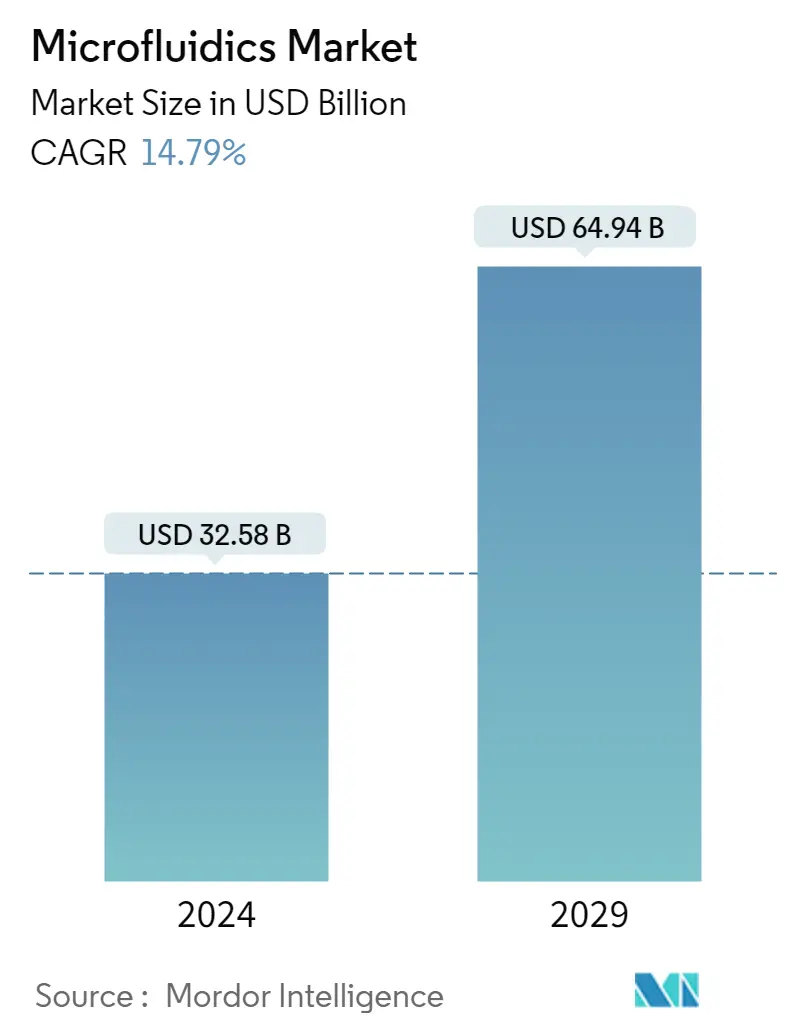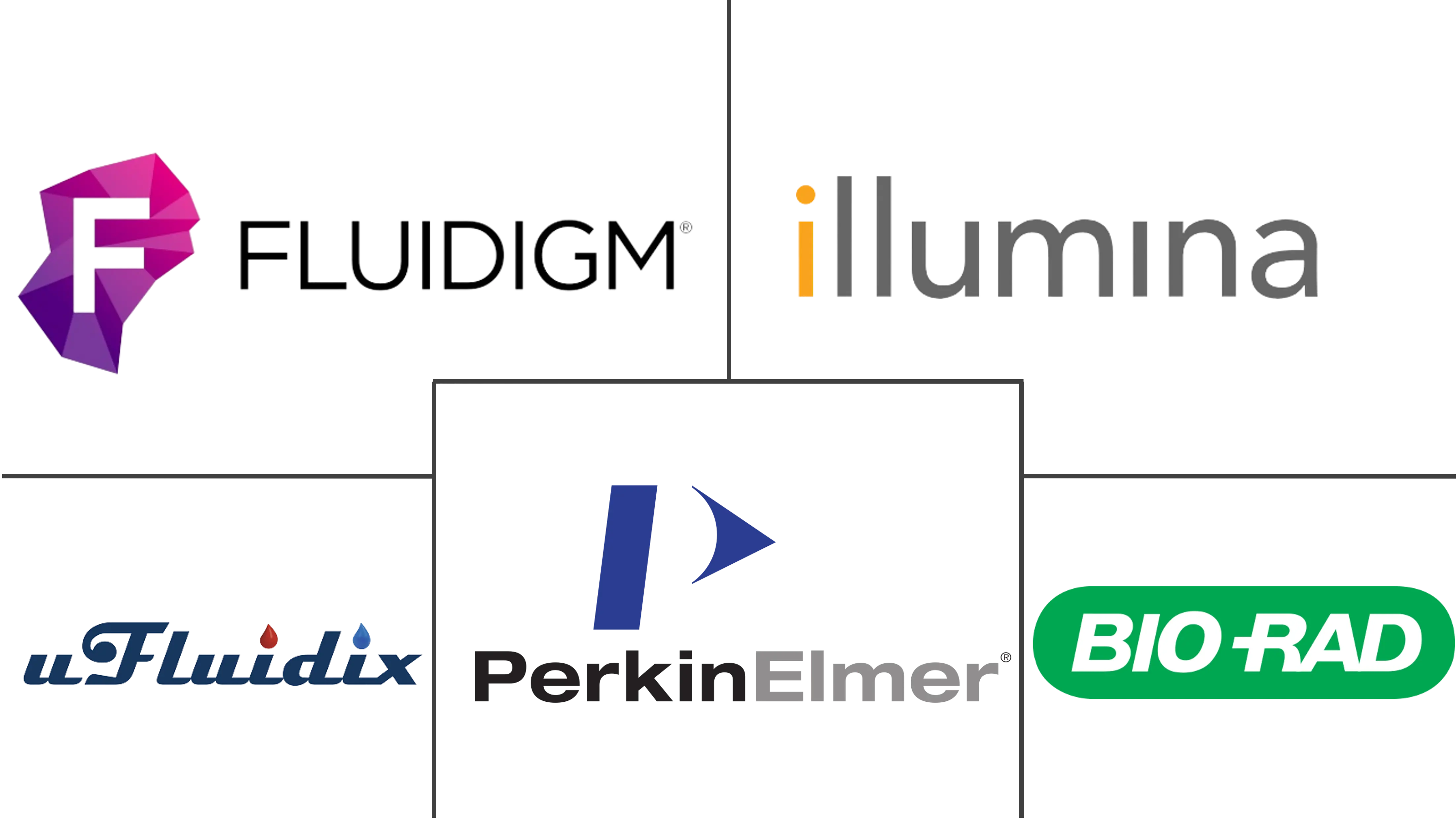Market Size of Microfluidics Industry

| Study Period | 2019 - 2029 |
| Market Size (2024) | USD 32.58 Billion |
| Market Size (2029) | USD 64.94 Billion |
| CAGR (2024 - 2029) | 14.79 % |
| Fastest Growing Market | Asia Pacific |
| Largest Market | North America |
Major Players
*Disclaimer: Major Players sorted in no particular order |
Need a report that reflects how COVID-19 has impacted this market and its growth?
Microfluidics Market Analysis
The Microfluidics Market size is estimated at USD 32.58 billion in 2024, and is expected to reach USD 64.94 billion by 2029, growing at a CAGR of 14.79% during the forecast period (2024-2029).
The COVID-19 pandemic had an impact on the healthcare market. During the initial phase of the pandemic, companies were engaged in developing various sensor devices and equipment for wearables and other mobile devices that are used for remote monitoring of chronically ill patients. The high number of COVID-19 cases among the population has increased the demand for point-of-care diagnostics for rapid and effective testing of a large number of samples. This has ultimately increased the development of numerous microfluidic technologies, which has impacted the market's growth. For instance, according to an article published in the Life Journal in May 2022, different techniques are used to detect SARS-CoV-2 antibodies, such as the microfluidic DA-D4 (double-antigen bridging immunoassay technique, which detects total antibodies including all subclasses and isotypes) and sandwich/competitive immune-sensors based methods that help run three samples per device and provide accurate results. As per the same source, the semi-automated microfluidic platform with the classic multilayer soft-lithography technique can detect antibodies against four SARS-CoV-2 antigens while running 50 samples in a single device. New significant opportunities are opening for point-of-care diagnostic test-makers and rapid, miniaturized microfluidic technologies, which are expected to drive the market's growth over the forecast period.
Certain factors propelling the market's growth are the increasing demand for point-of-care testing, rising incidences of chronic diseases, the faster turn-around time for analysis, and improved portability of devices.
The rising burden of infectious diseases and chronic diseases such as cancer, diabetes, cardiovascular diseases, and others increases the demand for point-of-care testing, which is expected to propel the demand for the microfluidics market over the forecast period. For instance, according to the 2022 statistics published by IDF, in Germany, about 6.1 million people were living with diabetes in 2021, which is projected to reach 6.5 million by 2030. Thus, the expected increase in the number of people suffering from diabetes raises the need for novel porous microcapsules encapsulating β cells for diabetes treatment using microfluidic electrospray technology.
A study published in PLOS One in January 2021 stated that about 2.8 million people are expected to have the chronic obstructive pulmonary disease (COPD) by 2025 in France. This is anticipated to increase the demand for testing for COPD using microfluidic chips and small samples of blood, hence boosting the market's growth. According to the 2022 statistics published by Dementia Australia, 487,500 Australians are living with dementia in Australia in 2022, and this number is projected to reach about 1.1 million by 2058. Thus, the increasing burden of dementia among the target population raises the need for effective drug discovery, screening methods, and toxicology studies. This increases the demand for microfluidics systems that can be used to grow neurites, glial cells, endothelial cells, and skeletal muscle cells, along with the maintenance of fluid isolation, and provides an opportunity to investigate organogenesis and disease etiology.
The developments in microfluidics are also leading to the evolution of a cost-effective mass-production process of diagnostic devices and smartphones being paired with microfluidics, thus enabling the deployment of point-of-care testing. This has widened the application of microfluidic devices and is expected to expand.
The rising company focus on developing microfluidics technologies and devices and increasing adoption of various strategic initiatives are expected to drive the market's growth over the forecast period. For instance, in June 2021, Sphere Fluidics, a company commercializing single-cell analysis systems underpinned by its patented picodroplet technology, and ClexBio, a pioneer in solutions for tissue engineering and single-cell techniques, launched the biocompatible CYTRIX Microfluidic Hydrogel Kit. In January 2021, LumiraDx approved a microfluidic immunofluorescence assay to detect SARS-CoV-2 antigens in Japan and Brazil.
However, the integration of microfluidics technology with existing workflows and the low adoption in developing countries due to high prices are expected to hinder the market's growth over the forecast period.
